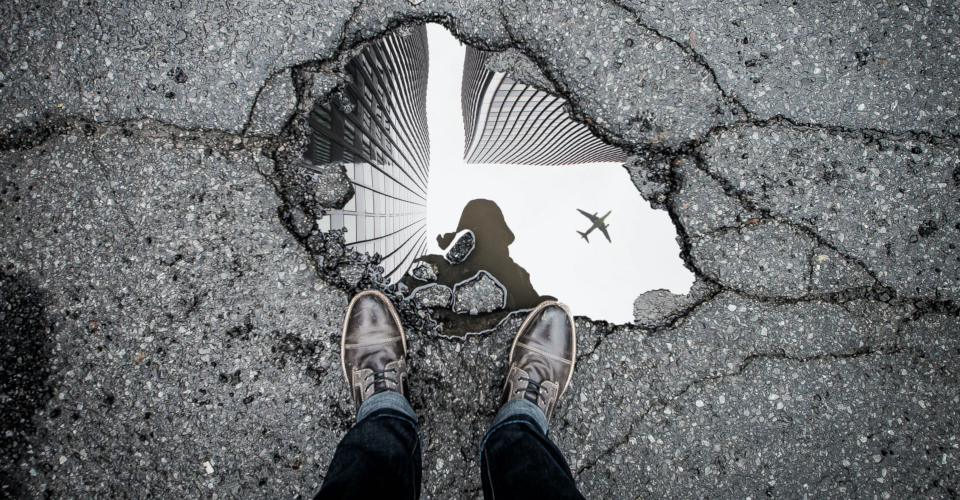How Will the UK Fix Potholes with 3D Printing?
In recent weeks, news outlets have been reporting the upcoming efforts of the UK to use a combination of drones and 3D printing to fix their huge problem with potholes. The novelty of the idea is certainly newsworthy. 3D printing and drones are two of the most high-profile emerging technologies that are being employed for innovative solutions to real-world problems.
Conspicuously absent from any press release is any detail on how exactly 3D printing will be used for this scenario. What type of 3D printing technology might be viable here?
The product of collaborative research

Just to be clear, the UK Department of Transportation has only recently announced this project as a multimillion-dollar initiative. It turns out that road conditions in England are so bad that 1.7 million potholes had to be repaired from 2020 to 2021. In this context, the government is now setting aside significant funding to address this problem.
The project to use drones and 3D printing for pothole repair came about the Digital Intelligent Brokerage (DIB), a collective of efforts to accelerate research and development. This is relevant as it is a movement that aims to explore innovative technologies. In this instance, the solution to the potholes problem may come from small businesses that may not be associated normally with the transportation sector.
According to the proposal, the identification of potholes will be done via a fleet of autonomous drones. This is a fairly complicated matter that has to be discussed in a separate article. While the technology certainly exists for drones to detect potholes via 3D modeling, having them fly autonomously is still going to be controversial.
In any case, the drone part of the pothole fix is not the topic of this article. Where does 3D printing come in?
3D printing of asphalt
The news announcement does not make any mention of the type of 3D printing technology being eyed for this project. Perhaps an indicator of the direction of the project can be gleaned from some of the other research works being done under DIB.
One such example is the use of graphite nano-particles in asphalt to reduce cracks in roads. There is another alternative that calls for the use of bio-bitumen. Although there are no details on its chemical composition, bio-bitumen has been described as an asphalt alternative that comes from eco-friendly materials.
The technology to 3D print asphalt already exists. A research paper published back in 2018 describes the design of an extruder that can the non-Newtonian fluid properties of asphalt. Moreover, the process temperature of 3D printing was found to have caused microstructural changes in asphalt that enhanced its mechanical properties.
A more recent development describes the design for an asphalt 3D printer by a team of scientists from Monash University and Chang’an University. Based on the infrastructure of a Prusa I3 3D printer, what made this project unique is that it came with a camera system that can automatically detect a crack or pothole in the road. Through an image-processing algorithm, the printer can then determine exactly where and how much asphalt it needs to extrude.
These are just two of the many projects undertaken through the years that sought to combine road repair with 3D printing. As we can see, the idea is not that new. However, the initiative by the UK might just be one of the most well-funded and has the highest chance of being implemented.
On-the-go pothole repair?
The idea behind combining drones and 3D printing for road repair is that most of the work can be done autonomously. This should cut down on the time spent for workers to go to every single pothole and set up their equipment. Over time, this should also result in a reduction in labor costs.
The UK Department of Transportation justifies that undertaking such a massive (and capital-intensive) project will result in numerous benefits. These include enhanced road safety, reduced travel times, lower vehicle emissions, and an overall improvement of asset values.
This is actually not the first time that such an idea has been explored in the UK. Just last year, there were news reports of the University of Liverpool supporting the efforts to build autonomous robots for fixing potholes.
The company Robotiz3D came about as an offshoot of the university for this project. The goal of the project was to design a ground-based robot that will patrol the roads in the UK, automatically detect small cracks, and inject sealant into them. In the case of potholes, the robot just takes measurements so that more heavy-duty repair can be done later.
How realistic is the idea?

Back in 2018, there was a video released by the University of Leeds showing a concept of a six-rotor drone with an attached delta 3D printer on its underside. The idea was for the drone to detect potholes as it flies overhead. It then lands on these potholes so that the attached 3D printer can do the repair work.
This concept may very well be what the UK Department of Transportation aims to achieve. Although promising, the concept video shown back in 2018 revealed several huge hurdles before the idea can become a reality.
The first major criticism is that repairing potholes requires more than just dumping asphalt into them. In most cases, potholes tend to have loose debris such as pieces of concrete, soil, and rocks inside them. These have to be removed before any asphalt is poured in. This is work that is done manually using shovels. Without this preparatory step, any new asphalt will tend to just collapse into the hole.
Mounting 3D printers to drones is pretty much out of the question. 3D printers tend to have very small build volumes that likely will not cover the area of an entire pothole. Repairing potholes will also require a significant volume of asphalt – much more than what a standard drone can carry.
Once the asphalt has been poured into a pothole, it needs to be tamped down whether manually or using industrial equipment. This is something that cannot be done by a 3D printer.
There is no doubt that autonomous pothole identification and inspection by drones is possible – drones are already doing much more complex tasks. However, we still cannot see how 3D printing could possibly be a practical solution to road repairs.
Even with 3D printers, there will still be a lot of manual work that needs to be done. This effectively invalidates the vision of this project presenting an “on-the-go” solution to road repairs. There is also the fact that the old-fashioned methods for pothole repair are very cheap. It can be done by two or three people with a few buckets of asphalt and some hand tools.
Right now, the idea of using 3D printing to repair potholes is unconvincing. The technology of 3D printing has gone far but developing new and innovative applications will still be very expensive. However, we are eager to be surprised by the ideas that the researchers in the UK could come up with. The great thing about this project is that it is receiving a lot of support and funding from the local government.
Final thoughts
Through the last couple of years, a lot of research has been done on the use of 3D printers for asphalt. There is certainly a huge value in this concept if 3D printers can be used to do high-precision road repair work. With the initiative of the UK Department of Transportation, much of these research efforts might just culminate into a real-world application.
It is still unclear exactly how 3D printing can be utilized in this field in a manner that is practical or economical. Repairing potholes is not expensive, it’s just really slow. Hopefully, this is news that we can revisit in a few months and find encouraging results.





